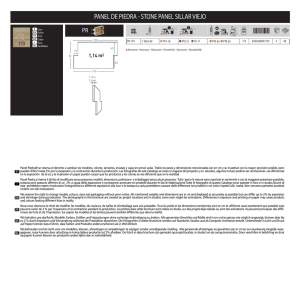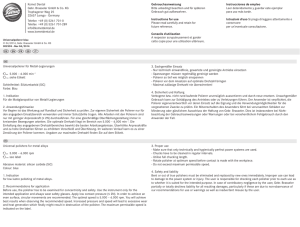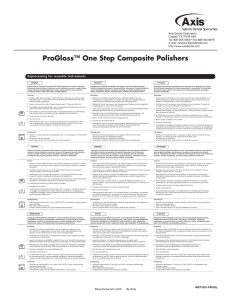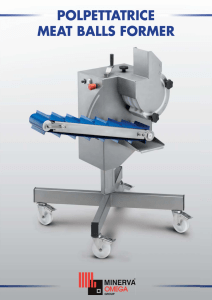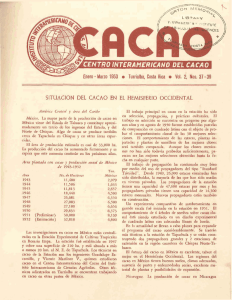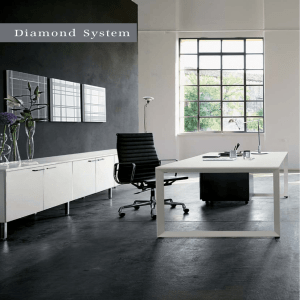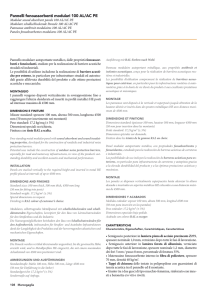expect the difference! by wieland.
Anuncio
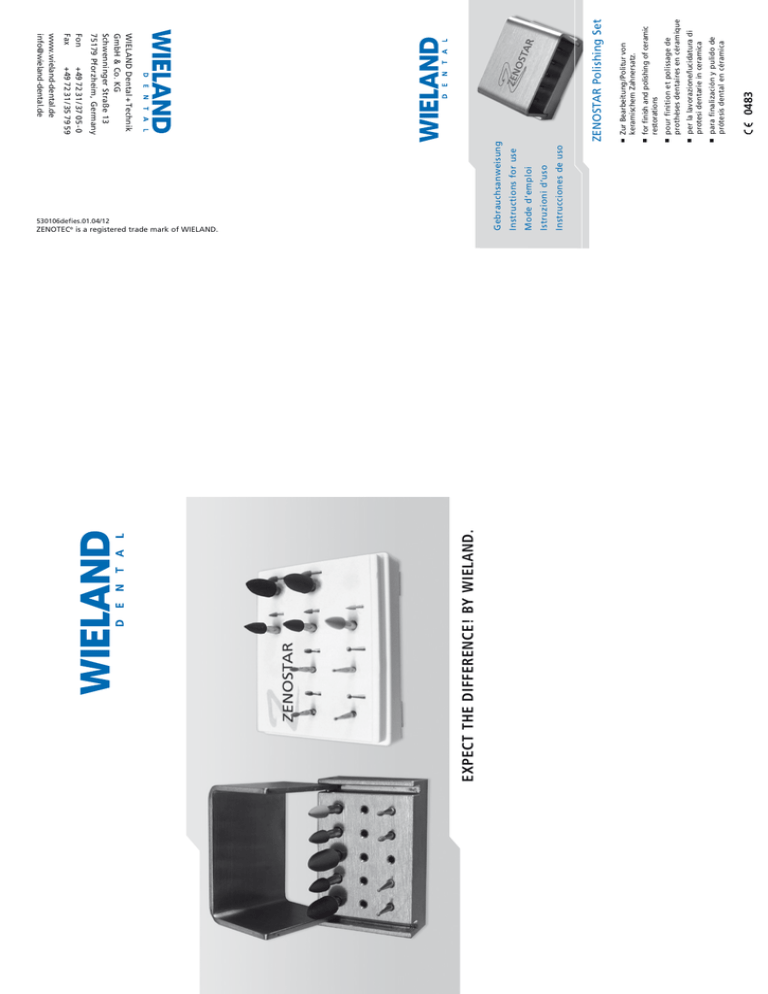
EXPECT THE DIFFERENCE! BY WIELAND. ZENOTEC® is a registered trade mark of WIELAND. Instrucciones de uso Istruzioni d’uso Mode d’emploi Instructions for use ara finalización y pulido de p prótesis dental en céramica 0483 er la lavorazione/lucidatura di p protesi dentarie in ceramica our finition et polissage de p prothèses dentaires en céramique f or finish and polishing of ceramic restorations ur Bearbeitung/Politur von Z keramischem Zahnersatz. ZENOSTAR Polishing Set Gebrauchsanweisung WIELAND Dental + Technik GmbH & Co. KG Schwenninger Straße 13 75179 Pforzheim, Germany Fon+49 72 31 / 37 05 - 0 Fax +49 72 31 / 35 79 59 www.wieland-dental.de info@wieland-dental.de 530106defies.01.04/12 D euts c h A llgemein es Empfohlene Drehzahlen für ZENOSTAR Polisher Die Diamantkorn belegten Schleifinstrumente ZENOSTAR Diamonds sowie die mit Diamantkorn durchsetzten ZENOSTAR Polisher sind vorgesehen für die fachgerechte Bearbeitung und hochwertige Politur von Zahnersatz durch den Behandler nach der Eingliederung im Mund. Das Set besteht aus 2 Produktgruppen: a) Galvanisch belegten Diamantschleifer ZENOSTAR Diamonds und b) Zahnärztliche mit Diamantkorn versetzte ZENOSTAR Polisher Kopfdurchmesser in 1/10 mm Drehzahlbereich (min-1) Maximale Drehzahl (min-1) 033 – 050 6.000 – 10.000 40.000 Das Nichtbeachten der maximal zulässigen Drehzahl führt zu einem erhöhten Sicherheitsrisiko. zu a) Das Set enthält insgesamt 4 Stück Diamantschleifer in einem 2-Kornsystem: ZENOSTAR Diamond Football fine (379) FG Schaft mit Durchmesser 014 (1,4 mm) ZENOSTAR Diamond Football extra fine (379) FG Schaft mit Durchmesser 014 (1,4 mm) ZENOSTAR Diamond Ball fine (801) FG Schaft mit Durchmesser 010 (1,0 mm) ZENOSTAR Diamond Ball extra fine (801) FG Schaft mit Durchmesser 010 (1,0 mm) Die Instrumente haben einen FG Schaft nach ISO 314 und werden in einer Turbine verwendet. Die feine Körnung ist für die Vorarbeit „Verschleifen/Abtragen/Versäubern“. Diese Instrumente haben eine rote Ringcodierung. Die extra-feine Körnung ist für „feineres Verschleifen“ und besitzt eine gelbe Ringkennzeichnung. zu b) Das Set enthält zudem 5 Diamantpolierer, nach einem 3 Kornstufensystem (grob, mittel, fein): ZENOSTAR Polisher Pre-polish (Point S) Durchmesser 033 (3,3 mm) ZENOSTAR Polisher Pre-polish (Point L) Durchmesser 050 (5,0 mm) ZENOSTAR Polisher Finish (Point S) Durchmesser 033 (3,3 mm) ZENOSTAR Polisher Finish (Point L) Durchmesser 050 (5,0 mm) ZENOSTAR Polisher Glossy (Point S) Durchmesser 033 (3,3 mm) 3. Anpresskräfte Überhöhte Anpresskräfte können bei Schleifinstrumenten zum Ausbrechen der Schleifkörper oder zum Verschmieren des Instrumentes und zur überhöhten Wärmeentwicklung führen. Überhöhte Andruckkräfte können durch Überhitzung auch zu einer Schädigung der Pulpa führen. 4. Kühlung Zur Vermeidung unerwünschter Wärmeentwicklung bei der Präparation ist eine ausreichende Kühlung mit einem Luft-/Wasserspray (mind. 50ml/min) sicherzustellen. Bei FG-Instrumenten mit einer Gesamtlänge von über 22mm oder einem Kopfdurchmesser über 2 mm ist zusätzliche Außenkühlung erforderlich. Bei unzureichender Wasserkühlung kann es zu einer irreversiblen Schädigung des Zahnes und der umliegenden Gewebe kommen. 5. Reinigung und Desinfektion Der Infektionsschutz ist für den Patienten und das Behandlungsteam von besonderer Bedeutung. Die Desinfektion und/oder Sterilisation der eingesetzten Arbeitsmittel sind Erfordernisse einer sicherheitsbetonten und verantwortungsvollen Verwendung. Vor dem Einsatz sind die Diamant- Schleifinstrumente entsprechend der Herstellerempfehlung zu sterilisieren. Nach der Verwendung und vor der Wiederverwendung sind die nachfolgenden Hygiene-Empfehlungen zu beachten. Die Diamantpolierer haben einen RA Schaft nach ISO 204 und werden in ein reduziertes Winkelstück (z. B. 1:3) eingespannt. Die farblich unterschiedlichen Polierinstrumente sind entsprechend der Kornstufe wie nachstehend beschrieben einzusetzen. Um ein optimales Ergebnis zu erzielen sollten alle Polierstufen – in Ihrer Reihenfolge (Blau, Rot und Grau) – eingehalten werden. 1. Grobe Körnung (blaufarbige ZENOSTAR Polisher Pre-polish, zum anschließenden Glätten nach dem „Einschleifen“), 2.Mittlere Körnung (rotfarbige ZENOSTAR Polisher Finish, zum Polieren) und 3.Feine Körnung (graufarbige ZENOSTAR Polisher Glossy, für den „optimalen Glanz“). Produkte für den dentalmedizinischen Bereich dürfen nur von Zahnärzten, Ärzten bzw. entsprechenden geschulten Fachkräften eingesetzt werden, die aufgrund ihrer Ausbildung und ihrer Erfahrung mit der Anwendung dieser Produkte vertraut sind und über entsprechende Kenntnisse in den jeweiligen Fachbereichen verfügen. Reinigung, Desinfektion, Sterilisation und Lagerung von Diamant-Schleif-/Polierinstrumenten: Gebrauchte Instrumente sind sofort in ein Bohrerbad mit dafür vorgesehenen Reinigungs- und Desinfektionslösungen einzulegen. Desinfektions- und Reinigungsmittel mit Korrosionsschutz verwenden. Es sind unbedingt die einschlägigen Anwendungsvorschriften der Reinigungs- und Desinfektionsmittelhersteller zu beachten. Gereinigte Instrumente sind vor jedem Einsatz auf Rückstände hin zu prüfen und allenfalls nachzureinigen. Die Instrumente können mit Ultraschall gereinigt werden. Die Verwendung von Bohrerständern oder -halter wird empfohlen um Schäden an den Instrumenten zu vermeiden. Sterilisation der Instrumente hat im Chemiklaven, Autoklaven oder mittels Heißluft zu erfolgen. Anmerkung: Um Übertragungen von infektiösen Keimen zu vermeiden, sollten mit Blut oder Schmutz kontaminierte Instrumente sorgfältig entsorgt werden. Gebrauc hs anleitun g Alle Instrumente wurden für ihre spezifische Anwendung entwickelt und konstruiert. Unsachgemäßer Gebrauch kann zu Schädigungen am Zahn, zum vorzeitigen Verschleiß, zur Zerstörung der Instrumente und zu einer Gefährdung für den Anwender, den Patienten oder Dritter führen. 1.Sachgemäße Anwendung Es ist darauf zu achten, nur technisch und hygienisch einwandfreie, gewartete und gereinigte Turbinen, sowie Hand- und Winkelstücke einzusetzen. Exakter Antriebsrundlauf von Turbine und Winkelstück ist notwendig. Beim Einsatz dieser Produkte ist darauf zu achten, dass mit ausreichend Wasserkühlung (50 ml/min) und minimalem Anpressdruck (2 N) gearbeitet wird. Die Instrumente müssen so tief wie möglich eingespannt werden. Die Instrumente sind vor dem Ansetzen an das Objekt auf Drehzahl zu bringen. Möglichst in leicht kreisförmigen Bewegungen arbeiten, um „Dellen“ und thermische Schäden zu vermeiden. Verbogene bzw. nicht rund laufende Instrumente müssen unverzüglich aussortiert werden. Polierer sind bei Bedarf zu zentrieren, um vibrationsfreies Arbeiten zu erreichen. Die ungeschützte Berührung der Instrumente und Teile durch den Anwender ist unbedingt zu vermeiden (Schutzhandschuhe verwenden). Eine Schutzbrille ist grundsätzlich empfohlen. 6901999020 Polishing Set Premium 6901999021 Polishing Set Basis 6901999022 ZENOSTAR Polisher Pre-polish (Point S) (5 Stk.) 6901999023 ZENOSTAR Polisher Pre-polish (Point L) (5 Stk.) 6901999024 ZENOSTAR Polisher Finish (Point S) (5 Stk.) 6901999025 ZENOSTAR Polisher Finish (Point L) (5 Stk.) 6901999026 ZENOSTAR Polisher Glossy (Point S) (5 Stk.) 6901999027 ZENOSTAR Diamond Football fine (5 Stk.) 6901999028 ZENOSTAR Diamond Football extra fine (5 Stk.) 6901999029 ZENOSTAR Diamond Ball fine (5 Stk.) 6901999030 ZENOSTAR Diamond Ball extra fine (5 Stk.) Unsachgemäße Anwendung führt zu schlechten Arbeitsergebnissen und erhöhtem Risiko. Die Anwendung von rotierenden Instrumenten darf nur durch qualifizierte Personen erfolgen. 2. Drehzahlempfehlungen Die maximal zulässige Drehzahl darf nie überschritten werden. Die empfohlenen Drehzahlen und maximal zulässigen Drehzahlen differieren von Produkt zu Produkt. Vergewissern Sie sich zu Ihrer Sicherheit und Sicherheit gegenüber Dritten über die empfohlenen Drehzahlen über die Angaben auf der Verpackung. Empfohlene Drehzahlen für ZENOSTAR Diamond Kopfdurchmesser in 1/10 mm Drehzahlbereich (min-1) Maximale Drehzahl (min-1) 008 – 010 75.000 – 150.000 450.000 012 – 014 60.000 – 110.000 450.000 016 – 018 45.000 – 88.000 450.000 021 – 023 40.000 – 75.000 300.000 0483 E ng l i s h General Diamond grit-coated ZENOSTAR diamonds and diamond coated ZENOSTAR polishers are designed for the professional grinding and high-quality polishing of dental restorations by dentists after inclusion in the mouth. There are 2 product-group sets: a) ZENOSTAR Diamonds and b) ZENOSTAR Polishers Set a) includes a total of 4 diamond rotaries in a 2-grit system ZENOSTAR Diamonds Football fine (379) FG shank with diameter 014 (1.4 mm) ZENOSTAR Diamonds Football extra fine (379) FG shank with diameter 014 (1.4 mm) ZENOSTAR Diamonds Kugel fine (801) FG shank with diameter 010 (1.0 mm) ZENOSTAR Diamonds Kugel extra fine (801) FG shank with diameter 010 (1.0 mm) The instruments have an FG shank according to ISO 314 and are used in a turbine. The fine grit is for preliminary „grinding/eroding/cleaning“. These instruments have red ring codes. The extra-fine grit is for „finer grinding“ and has a yellow ring code. Set b) also includes 5 diamond polishers in a 3-grit system (coarse, medium, and fine): ZENOSTAR Polisher Pre-polish (S head) Diameter 033 (3.3 mm) ZENOSTAR Polisher Pre-polish (L head) Diameter 050 (5.0 mm) ZENOSTAR Polisher Finish (S head) Diameter 033 (3.3 mm) ZENOSTAR Polisher Finish (L head) Diameter 050 (5.0 mm) ZENOSTAR Polisher Glossy (S head) Diameter 033 (3.3 mm) 3. Compressive force Excessive compressive force can cause grinding tools to crack, become clogged or overheat. Excessive compressive force can also damage the pulp through overheating. 4. Cooling To prevent unwanted heat during preparation, use an air/water spray (min. 50 ml/min) to ensure sufficient cooling. FG instruments with a total length of over 22mm or a head diameter of over 2 mm will require additional external cooling. Insufficient water cooling can cause irreversible damage to the tooth and the surrounding tissue. 5. Cleaning and disinfection Protection against infection is very important for both the patient and the treatment team. Disinfection and/ or sterilization of the used equipment are essential for safe and responsible use. Before use, the diamond grinding instruments should be sterilized according to the manufacturer‘s instructions. After use and before reuse, the following hygiene recommendations should be implemented. Cleaning, disinfection, sterilization and storage of diamond grinding/polishing instruments: Place used instruments immediately afterwards in a drill bath containing appropriate cleaning and disinfecting solutions. Use disinfectants and cleaning agents with corrosion protection. Pay close attention to the manufacturer‘s cleaning and disinfecting instructions. Check cleaned instruments before each use and clean them again if necessary. The instruments can be ultrasonically cleaned. Use of drill stands or drill holders is recommended to avoid damage to the instruments. Sterilize the instruments in a chemiclave, autoclave or using hot air. The diamond polishers have an RA shank according to ISO 204 and are fixed in a reduced angle (e.g. 1:3). The colour-coded polishing instruments are to be used according to grit size as described below. To achieve an optimal result, all polishing steps should be carried out in sequence (blue, red and grey). 1. Coarse grit (blue ZENOSTAR Pre-polish polisher, for smoothing after „grinding“), 2. Medium grit (red ZENOSTAR Finish polisher, for polishing) and 3. Fine grit (grey ZENOSTAR Glossy polisher, for „optimal shine“). Note: In order to prevent transmission of infectious pathogens, instruments contaminated with blood or dirt should be disposed of carefully. Forms of supply: Products for use in dentistry should only be used by dentists, doctors or trained professionals who are familiar with them, know how to use them, and have specialist knowledge of the respective areas. I nstructions All the instruments have been developed and constructed for specific uses. Improper use may cause damage to the teeth, premature wear, and destruction of the instruments, and may also endanger the user, patient or third party. 1. Correct use Use only technically sound and thoroughly hygienic, serviced and cleaned turbines. The same applies to handpieces and angle pieces. Precise drive concentricity of both the turbine and the angle piece is required. When using these products, make sure that you use sufficient cooling water (50 ml/min) and minimum grinding pressure (2 N). Fix the instruments as low as possible. Bring the instruments to speed before placing them on the object. Movements should be lightly circular where possible to avoid „bumps“ and thermal damage. Discard bent or non-evenly running instruments immediately. Centre polishers where necessary to enable vibration-free operation. Avoid unprotected contact with the instruments and parts at all times (use gloves). The use of goggles is generally recommended. 6901999020 Polishing Set Premium 6901999021 Polishing Set Basis 6901999022 ZENOSTAR Polisher Pre-polish (Point S) (5 units) 6901999023 ZENOSTAR Polisher Pre-polish (Point L) (5 units) 6901999024 ZENOSTAR Polisher Finish (Point S) (5 units) 6901999025 ZENOSTAR Polisher Finish (Point L) (5 units) 6901999026 ZENOSTAR Polisher Glossy (Point S) (5 units) 6901999027 ZENOSTAR Diamond Football fine (5 units) 6901999028 ZENOSTAR Diamond Football extra fine (5 units) 6901999029 ZENOSTAR Diamond Ball fine (5 units) 6901999030 ZENOSTAR Diamond Ball extra fine (5 units) Improper use leads to inferior results and increased risk. Rotating instruments should only be used by qualified individuals. 2. Speed recommendations The maximum permissible speed should never be exceeded. The recommended speeds and maximum permissible speeds vary from product to product. Please ensure for your own safety and the safety of others that you are aware of the recommended speeds printed on the packaging. Recommended speeds for ZENOSTAR Diamond Head diameter in 1/10 mm Speed range (min-1) Maximum speed (min-1) 008 – 010 75,000 – 150,000 450,000 012 – 014 60,000 – 110,000 450,000 016 – 018 45,000 – 88,000 450,000 021 – 023 40,000 – 75,000 300,000 Recommended speeds for ZENOSTAR Polisher Head diameter in 1/10 mm Speed range (min-1) Maximum speed (min-1) 033 – 050 6.000 – 10.000 40.000 Failure to observe the maximum permissible speeds will result in an increased safety risk. 0483 Franç ai s G énéralités Vitesses de rotation recommandées pour ZENOSTAR Diamonds Les grains de diamant qui recouvrent les instruments de fraisage ZENOSTAR Diamond de même que le grain de diamant du ZENOSTAR Polisher sont prévus pour la finition professionnel et le polissage de prothèse dentaire après le placement dans la bouche par le praticien. Le kit se compose de 2 groupes de produits: a) Fraise diamantée à liant galvanique ZENOSTAR Diamond et b) Polisseur dentaire avec grain diamant ZENOSTAR Polisher pour a) Le kit se compose en tout de 4 unités de polisseur diamant dans un système à 2 grains: ZENOSTAR Diamond Football fine (379) FG shaft avec diamètre 014 (1,4 mm) ZENOSTAR Diamond Football extra fine (379) FG shaft avec diamètre 014 (1,4 mm) ZENOSTAR Diamond Ball fine (801) FG shaft avec diamètre 010 (1,0 mm) ZENOSTAR Diamond Ball extra fine (801) FG shaft avec diamètre 010 (1,0 mm) Les instruments ont un FG shaft conforme à ISO 314 et sont utilisés dans une turbine. Le grain fin est pour la préparation „fraiser/retirer/nettoyer“. Ces instruments présentent un codage annulaire rouge. La granulation extra-fine est pour „polissage fin“ et possède une désignation annulaire jaune. pour b) Le kit contient en outre 5 polisseurs diamant, d‘après un système avec granulation par plage de 3 (grossier, moyen, fin): ZENOSTAR Polisher Pre-polish (Point S) Diamètre 033 (3,3 mm) ZENOSTAR Polisher Pre-polish (Point L) Diamètre 050 (5,0 mm) ZENOSTAR Polisher Finish (Point S) Diamètre 033 (3,3 mm) ZENOSTAR Polisher Finish (Point L) Diamètre 050 (5,0 mm) ZENOSTAR Polisher Glossy (Point S) Diamètre 033 (3,3 mm) Les polisseurs diamant ont un RA shaft conformément à ISO 204 et sont serrés dans un contre-angle réduit (p.ex. 1:3). Les instruments de polissage désignés par des couleurs différentes sont à utiliser selon la granulation comme décrit ci-après. Pour obtenir un résultat optimal, il faut respecter l‘ordre des étapes des systèmes de polissage – dans leur étape successive (Bleu, Rouge et Gris). 1. Grain grossier (couleur bleue ZENOSTAR Polisher Pre-polish,pour le ponçage qui suit le „fraisage“), 2. Grain moyen (couleur rouge ZENOSTAR Polisher Finish, pour polir) et 3. Grain fin (couleur grise ZENOSTAR Polisher Glossy, pour le „brillant optimal“). Les produits à usage clinique sont exclusivement réservés à l‘usage des dentistes, médecins ou autres cliniciens formés à cet effet, qui disposent d‘une expérience acquise dans une formation spécifique et habilités à se servir de ces produits et ayant les connaissances requises pour la spécialité. N otice d‘u tilis atio n Tous les instruments ont été développés et fabriqués pour l‘usage spécifique qui leur est destiné. Une utilisation non conforme conduit à des endommagements des dents, à l‘usure prématurée, à la destruction des instruments et la mise en danger de l‘utilisateur, des patients ou des tiers. 1. Utilisation conforme Veiller à utiliser exclusivement des turbines en bon état et parfaitement entretenues du point de vue de la technique et de l‘hygiène, de même que pour les pièces à main et les contre-angles. La concentricité exacte des turbines et des fraises est indispensable. Lors de l‘utilisation de ces produits, veiller à une bonne irrigation de refroidissement (50 ml/min) et à exercer une pression minimale de (2 N). Insérer les instruments aussi profondément que possible. Mettre l‘instruments en route à la vitesse de rotation souhaitée avant de l‘appliquer sur l‘objet. Travailler autant que possible en exerçant de légers mouvements circulaires, afin d‘éviter les „creux“ et les dommages thermiques. Les instruments tordus ou excentrés doivent être retirés immédiatement. Centrer les polisseurs si nécessaire, pour obtenir un travail sans vibrations. L‘utilisateur doit absolument éviter de toucher les instruments et les pièces sans protection (Porter des gants de protection). Le port de lunettes de protection est systématiquement recommandé. Une utilisation non conforme entraîne des résultats insatisfaisants et augmente les risques d’échecs. L‘utilisation d‘instruments rotatifs doit seulement être confiée à un personnel qualifié. 2. Recommandations de vitesse de rotation Ne jamais dépasser la vitesse de rotation maximale permise. Les vitesses de rotation recommandées maximales et permises varient d‘un produit à l‘autre. Respectez impérativement les recommandations ainsi que les vitesses indiquées dans les informations techniques et sur les étiquettes pour votre propre sécurité et celle d‘autrui. Diamètre de tête en 1/10 mm Plage de vitesse de rotation (min-1) Vitesse de rotation maximale (min-1) 008 – 010 75.000 – 150.000 450.000 012 – 014 60.000 – 110.000 450.000 016 – 018 45.000 – 88.000 450.000 021 – 023 40.000 – 75.000 300.000 Vitesses de rotation recommandées pour polisseur ZENOSTAR Polisher Diamètre de tête en 1/10 mm Plage de vitesse de rotation (min-1) Vitesse de rotation maximale (min-1) 033 – 050 6.000 – 10.000 40.000 Le non respect de la vitesse de rotation maximale autorisée entraîne une augmentation du risque au niveau de la sécurité. 3. Forces de pression Des forces de pression trop importantes exercées sur les instruments de fraisage risquent de provoquer la fracture du corps de fraisage ou le graissage de l‘instrument et générer une forte chaleur. Des forces de pression de travail trop importantes risquent d‘entraîner un échauffement et également d‘endommager la pulpe dentaire. 4. Refroidissement Pour éviter un dégagement thermique indésirable lors de la préparation, il convient d‘assurer un refroidissement suffisant avec un spray à air/eau (mini 50ml/min). Pour les instruments FG à tige longue plus de 22 mm au total, ou avec une partie travaillante de plus de 2 mm, il est nécessaire de prévoir un refroidissement externe supplémentaire. En cas d‘irrigation de refroidissement insuffisante, ceci peut entraîner une détérioration irréversible de la dent et de son environnement. 5. Nettoyage et désinfection La protection contre l‘infection est de très grande importance tant au niveau des patients que de l‘équipe soignante. La désinfection et/ou stérilisation des moyens de travail utilisés sont les impératifs dans le cadre d‘une utilisation responsable et en toute sécurité. Avant leur utilisation, les instruments de fraisage diamant doivent être stérilisés conformément aux recommandations du fabricant. Après leur utilisation et avant leur réutilisation, il convient de respecter les mesures d‘hygiène suivantes. Nettoyage, désinfection, stérilisation et stockage des instruments de polissage et fraisage diamant : Les instruments utilisés doivent être immédiatement placés dans un bain pour fraise avec les solutions nettoyantes et désinfectantes prévues à cet effet. Utiliser des désinfectants et des nettoyants avec une protection contre la corrosion. Respecter impérativement les directives d‘utilisation préconisées par le fabricant de désinfectants et de nettoyants. Avant chaque utilisation, vérifier si les instruments sont parfaitement nettoyés et dans tous les cas les nettoyer. Les instruments peuvent être nettoyés aux ultrasons. Il est recommandé d‘utiliser des porte-fraises ou supports afin d‘éviter d‘endommager les instruments. La stérilisation des instruments doit être effectuée dans des chemiclaves, autoclaves ou au moyen de chaleur sèche. Remarque : Afin d‘éviter la transmission de germes infectieux, les instruments contaminés par du sang ou souillés doivent être éliminés avec le plus grand soin. 6901999020 Polishing Set Premium 6901999021 Polishing Set Basis 6901999022 ZENOSTAR Polisher Pre-polish (Point S) (5 pc.) 6901999023 ZENOSTAR Polisher Pre-polish (Point L) (5 pc.) 6901999024 ZENOSTAR Polisher Finish (Point S) (5 pc.) 6901999025 ZENOSTAR Polisher Finish (Point L) (5 pc.) 6901999026 ZENOSTAR Polisher Glossy (Point S) (5 pc.) 6901999027 ZENOSTAR Diamond Football fine (5 pc.) 6901999028 ZENOSTAR Diamond Football extra fine (5 pc.) 6901999029 ZENOSTAR Diamond Ball fine (5 pc.) 6901999030 ZENOSTAR Diamond Ball extra fine (5 pc.) 0483 Ital i ano Generalit à Numeri di giri consigliati per strumenti ZENOSTAR Diamond Gli strumenti abrasivi ZENOSTAR Diamond, rivestiti di grano di diamante, ed i lucidatori ZENOSTAR Polisher, compenetrati di grano di diamante, sono previsti per la lavorazione, a regola d’arte, e la lucidatura di alta qualità di protesi dentarie da parte del medico curante dopo l’inserimento in bocca. Il set è costituito da 2 gruppi di prodotto: a) strumento abrasivo diamantato, rivestito galvanicamente, ZENOSTAR Diamond e b) lucidatore odontoiatrico, compenetrato di grano di diamante, ZENOSTAR Polisher Riguardo ad a) Il set contiene in tutto 4 pezzi di strumenti abrasivi diamantati, in un sistema di 2 grossezze della grana: ZENOSTAR Diamond football fine (379) Gambo FG di diametro 014 (1.4 mm) ZENOSTAR Diamond football finissimo (379) Gambo FG di diametro 014 (1.4 mm) ZENOSTAR Diamond sfera fine (801) Gambo FG di diametro 010 (1.0 mm) ZENOSTAR Diamond sfera finissimo (801) Gambo FG di diametro 010 (1.0 mm) Gli strumenti hanno un gambo FG secondo ISO 314 e vengono utilizzati in una turbina. La grana fine è per il lavoro preliminare „levigare/asportare/rifinire“. Questi strumenti hanno una codificazione anulare rossa. La grana finissima è prevista per una „levigatura più fine” e presenta una codificazione anulare gialla. Riguardo a b) Il set contiene inoltre 5 lucidatori diamantati, secondo un sistema di 3 grossezze della grana (grossa, media, fine): ZENOSTAR Polisher Pre-polish (punta S) Diametro 033 (3.3 mm) ZENOSTAR Polisher Pre-polish (punta L) Diametro 050 (5.0 mm) ZENOSTAR Polisher Finish (punta S) Diametro 033 (3.3 mm) ZENOSTAR Polisher Finish (punta L) Diametro 050 (5.0 mm) ZENOSTAR Polisher Glossy (punta S) Diametro 033 (3.3 mm) I lucidatori diamantati hanno un gambo RA secondo ISO 204 e vengono serrati in una squadra o angolare ridotto (p.es. 1:3). Gli strumenti di lucidatura, di colore diverso, vanno usati secondo la grossezza della grana, come descritto qui di seguito. Per ottenere un risultato ottimale, osservare per tutte le fasi di lucidatura la loro successione (blu, rosso e grigio). 1. Grana grossa (lucidatori ZENOSTAR Polisher Pre-polish di colore blu, per la lisciatura dopo la „levigatura“), 2. grana media (lucidatori ZENOSTAR Polisher Finish di colore rosso, per lucidare) e 3. grana fine (lucidatori ZENOSTAR Polisher Glossy di colore grigio per la “lucentezza ottimale”). I prodotti per il settore medico-dentale possono solo essere usati da dentisti, medici o specialisti adeguatamente istruiti, i quali, in base alla loro formazione ed alla loro esperienza, hanno dimestichezza con l’impiego di questi prodotti e dispongono di relative cognizioni specifiche dei rispettivi settori. I struz ion i d’u s o Tutti gli strumenti sono stati progettati e costruiti per il loro uso specifico. Un uso non appropriato può portare a danneggiamento del dente, usura anticipata, distruzione degli strumenti e ad un pericolo per l’utilizzatore, il paziente o terzi. 1. Uso appropriato Badare che vengano usati esclusivamente turbine, impugnature ed angolari che siano, dal punto di vista tecnico ed igienico, perfetti, sottoposti a manutenzione e puliti. È necessaria un’esatta coassialità d’azionamento di turbina ed angolare. Nell’uso di questi prodotti si deve badare di lavorare con sufficiente raffreddamento ad acqua (50 ml/min) e minima pressione d’appoggio (2N). Gli strumenti vanno serrati il più profondo possibile. Prima di appoggiare sull’oggetto, gli strumenti devono essere portati al numero di giri d’avviamento. Per evitare „rientranze“ e danni termici, lavorare, possibilmente, con movimenti leggermente circolari. Gli strumenti deformati o che non girano coassiali devono essere scartati immediatamente. Per ottenere una lavorazione esente da vibrazioni, i lucidatori vanno, all’occorrenza, centrati. L’utilizzatore deve assolutamente evitare il contatto non protetto con gli strumenti ed i pezzi (usare guanti di protezione). Di principio si consiglia l’uso d’occhiali di protezione. L’uso non appropriato comporta cattivi risultati di lavorazione e maggiori rischi. L’uso di strumenti rotanti può solo avvenire da parte di persone qualificate. 2. Numeri di giri consigliati Il massimo numero di giri ammesso non deve mai essere superato. I numeri di giri consigliati ed i massimi numeri di giri ammessi differiscono da prodotto a prodotto Per la propria sicurezza e per la sicurezza nei confronti di terzi accertarsi, attraverso le indicazioni sulla confezione, dei numeri di giri consigliati. Diametro testa in 1/10 mm Intervallo numero di giri (min-1) Massimo numero di giri (min-1) 008 – 010 75.000 – 150.000 450.000 012 – 014 60.000 – 110.000 450.000 016 – 018 45.000 – 88.000 450.000 021 – 023 40.000 – 75.000 300.000 Numeri di giri consigliati per lucidatori ZENOSTAR Polisher Diametro testa in 1/10 mm Intervallo numero di giri (min-1) Massimo numero di giri (min-1) 033 – 050 6.000 – 10.000 40.000 La non osservanza del massimo numero di giri ammissibile porta ad un maggior rischio per la sicurezza. 3. Forze o pressioni d’appoggio Forze d’appoggio eccessive possono portare per strumenti abrasivi alla rottura degli abrasivi o all’impastarsi dello strumento e ad un eccessivo sviluppo di calore. Eccessive forze d’appoggio possono, a causa di surriscaldamento, anche portare ad un danneggiamento della polpa. 4. Raffreddamento Per evitare un indesiderato sviluppo di calore durante la preparazione si deve garantire un sufficiente raffreddamento con uno spray aria/acqua (min. 50ml/min ). Con strumenti FG, aventi una lunghezza totale di oltre 22 mm o un diametro della testa di oltre 2 mm, è inoltre necessario un raffreddamento esterno. Nel caso d’insufficiente raffreddamento ad acqua, può verificarsi un danneggiamento irreversibile del dente e dei tessuti circostanti. 5. Pulizia e disinfezione La protezione contro infezioni è di particolare importanza per il paziente e il team medico. La disinfezione e/o sterilizzazione degli strumenti di lavoro utilizzati sono esigenze di un utilizzo responsabile e che da importanza alla sicurezza. Prima dell’uso gli strumenti abrasivi diamantati devono essere sterilizzati secondo le istruzioni del produttore. Dopo l’utilizzo e prima della riutilizzazione vanno osservati i seguenti consigli d’igiene: Pulizia, disinfezione, sterilizzazione e conservazione degli strumenti abrasivi diamantati/ lucidatori: Gli strumenti usati vanno subito messi in un bagno per fresette con le soluzioni detergenti e disinfettanti a tal fine previste. Usare disinfettanti e detergenti con anticorrosivi. Osservare assolutamente le relative istruzioni d’uso dei produttori dei detergenti e disinfettanti. Gli strumenti puliti vanno, prima di ogni uso, controllati circa eventuali residui ed semmai ripuliti. Gli strumenti possono essere puliti con ultrasuoni. Per evitare danni agli strumenti, si consiglia l’impiego di sostegni o supporti per fresette. La sterilizzazione degli strumenti deve avvenire in autoclave chimico, autoclave o mediante aria calda. Osservazione: Per evitare una trasmissione di germi infettivi, gli strumenti contaminati con sangue o sporco vanno smaltiti con grande accuratezza. 6901999020 Polishing Set Premium 6901999021 Polishing Set Basis 6901999022 ZENOSTAR Polisher Pre-polish (Point S) (5 pz.) 6901999023 ZENOSTAR Polisher Pre-polish (Point L) (5 pz.) 6901999024 ZENOSTAR Polisher Finish (Point S) (5 pz.) 6901999025 ZENOSTAR Polisher Finish (Point L) (5 pz.) 6901999026 ZENOSTAR Polisher Glossy (Point S) (5 pz.) 6901999027 ZENOSTAR Diamond Football fine (5 pz.) 6901999028 ZENOSTAR Diamond Football extra fine (5 pz.) 6901999029 ZENOSTAR Diamond Ball fine (5 pz.) 6901999030 ZENOSTAR Diamond Ball extra fine (5 pz.) 0483 E spa ñol Explicac ión general Revoluciones recomendadas para ZENOSTAR Diamonds Las herramientas abrasivas recubiertas con granos de diamante ZENOSTAR Diamond y las herramientas de pulir diamantadas ZENOSTAR Polisher se han diseñado para la utilización profesional y el pulido de las restauraciones de alta calidad para el dentista, después de la inclusión en la boca. El set se compone de dos grupos de productos: a) Amoladoras diamantadas ZENOSTAR Diamond b) Herramientas diamantadas para el pulido odontológico ZENOSTAR Polisher para a) el set contiene en total 4 amoladoras diamantadas con 2 tamaños de granos: ZENOSTAR Diamond Football fine (379) FG vástago con diámetro 014 (1.4 mm) ZENOSTAR Diamond Football extra fine (379) FG vástago con diámetro 014 (1.4 mm) ZENOSTAR Diamond Ball fine (801) FG vástago con diámetro 010 (1.0 mm) ZENOSTAR Diamond Ball extra fine (801) FG vástago con diámetro 010 (1.0 mm) Los instrumentos tienen un vástago FG con la norma ISO 314 y se utilizan en una turbina. El grano fino es para el trabajo preparatorio de “lijado/alisado/acabado”. Estos instrumentos tienen un código de anillo rojo. El grano extra-fino es para „lijar más fino” y tiene un anillo de color amarillo. para b) El sistema contiene también 5 pulidoras de diamantes, de acuerdo con un sistema de tres niveles de grano (grueso, medio y fino): ZENOSTAR Polisher Pre-polish (Point S) Diámetro 033 (3.3 mm) ZENOSTAR Polisher Pre-polish (Point L) Diámetro 050 (5.0 mm) ZENOSTAR Polisher Finish (Point S) Diámetro 033 (3.3 mm) ZENOSTAR Polisher Finish (Point L) Diámetro 050 (5.0 mm) ZENOSTAR Polisher Glossy (Point S) Diámetro 033 (3.3 mm) Las pulidoras de diamantes tienen un eje AR de acuerdo con la norma ISO 204 y se sujetan en una pieza ángulada reducida (por ejemplo, 1:3). Los instrumentos de pulido tienen diferentes colores de acuerdo con el nivel de grano para su uso, como se describe a continuación. Para lograr resultados óptimos, hay que seguir todos los pasos del pulido en su orden (azul, rojo y gris). 1. Grano grueso (pulidor de color azul, ZENOSTAR Polisher Pre-polish, para suavizar despues de repasar) 2. Grano mediano (pulidor de color rojo, ZENOSTAR Polisher Finish, para pulir) 3. Grano fino (pulidor de color gris, ZENOSTAR Polisher Glossy, para el „brillo óptimo“). Los productos para la medicina dental sólo pueden ser utilizados por los dentistas, médicos y profesionales capacitados que estén familiarizados debido a su formación y experiencia en el uso de estos productos y tengan el conocimiento en sus respectivos campos. I nstrucc iones d e us o Todos los instrumentos han sido desarrollados y diseñados para su aplicación específica. El uso inadecuado puede causar daños a los dientes, desgaste prematuro, o la destrucción de los instrumentos y es un peligro para el usuario, el paciente o de terceros. 1. Aplicación correcta Es importante asegurarse de que sólo se utilizen turbinas, piezas de mano y piezas anguladas en perfectas condiciones de funcionamiento. Es necesario que la rotación de la transmisión de la turbina y del codo sean exactas. Asegurarse utilizar estos productos con suficiente agua de refrigeración (50 ml/min) y presión mínima (2N). Los instrumentos deben ser sujetos tan profundo como sea posible. El instrumento debe acelerarse antes de ser colocada en el objeto. Si es posible se debe trabajar con movimientos circulares para evitar „abolladuras“ y daños térmicos. Instrumentos doblados o no rotativos hay que desecharlos de inmediato. Si es necesario se deben centrar las pulidoras a fin de lograr un funcionamiento sin vibraciones. Hay que evitar el contacto sin protección de las herramientas y de las piezas por el usuario (use guantes). Se recomienda siempre protección de los ojos. La aplicación inadecuada conduce a resultados inferiores y un mayor riesgo. El uso de instrumentos rotatorios deben ser realizados por personas calificadas. 2. Recomendaciones de velocidad La velocidad máxima autorizada no debe superarse. Las velocidades recomendadas y las velocidades máximas varían de producto a producto. Garantize su seguridad y la seguridad de terceros, cumpliendo con las revoluciones recomendadas en la información del envase. Diámetro de cabeza Rango de revoluciones (min-1) Revoluciones máximas (min-1) en 1/10 mm 75.000 – 150.000 450.000 008 – 010 60.000 – 110.000 450.000 012 – 014 45.000 – 88.000 450.000 016 – 018 40.000 – 75.000 300.000 021 – 023 Revoluciones recomendadas para ZENOSTAR Polisher Diámetro de cabeza en 1/10 mm Rango de revoluciones (min-1) Revoluciones máximas (min-1) 033 – 050 6.000 – 10.000 40.000 El incumplimiento de la velocidad máxima permitida lleva a un mayor riesgo de seguridad. 3. Fuerzas de presión El aumento de la presión de contacto puede llevar al desprendimiento de la granulación de diamantes o a la obstrucción del instrumento y al calor excesivo. Una presión excesiva puede causar un sobrecalentamiento y daño a la pulpa. 4. Enfriamiento Para evitar el calor no deseado durante la preparación, debe ser garantizada una refrigeración adecuada con un spray aire/agua (mínimo 50 ml / min). En instrumentos FG con una longitud total de más de 22 mm o un diámetro de la cabeza de mas de 2 mm es necesario una refrigeración externa adicional. Sin suficiente enfriamiento de agua, se puede provocar daños irreversibles en el diente y el tejido circundante. 5. Limpieza y desinfección La protección contra la infección es para el paciente y el equipo de tratamiento de particular importancia. La desinfección y / o esterilización de los equipos utilizados son los requisitos de una inversión segura y el uso responsable. Antes de utilizar instrumentos de pulido de diamantes deben ser esterilizados de acuerdo a la recomendación del fabricante. Después de su uso y antes de su reutilización, deben seguir las siguientes recomendaciones de higiene. Limpieza, desinfección, esterilización y almacenamiento de instrumentos diamantados: Los instrumentos usados son presentados en un baño con la limpieza adecuada y soluciones desinfectantes. Deben usar desinfectantes y productos de limpieza con protección contra la corrosión. Es obligatorio cumplir con las orientaciones pertinentes de limpieza y desinfección según los fabricantes. Los instrumentos esterilizados deben ser revisados antes de cada uso y si es necesario volverlos a limpiar. Los instrumentos se pueden limpiar con ultrasonido. El uso del soporte del taladro se recomienda para evitar daños a los instrumentos. La esterilización de los instrumentos deben ser realizados en quimiclave, autoclave o por aire caliente. Tenga en cuenta: Con el fin de evitar la transmisión de patógenos infecciosos, con instrumentos contaminados con sangre o suciedades, estos deben ser cuidadosamente eliminados. 6901999020 Polishing Set Premium 6901999021 Polishing Set Basis 6901999022 ZENOSTAR Polisher Pre-polish (Point S) (5 piezas) 6901999023 ZENOSTAR Polisher Pre-polish (Point L) (5 piezas) 6901999024 ZENOSTAR Polisher Finish (Point S) (5 piezas) 6901999025 ZENOSTAR Polisher Finish (Point L) (5 piezas) 6901999026 ZENOSTAR Polisher Glossy (Point S) (5 piezas) 6901999027 ZENOSTAR Diamond Football fine (5 piezas) 6901999028 ZENOSTAR Diamond Football extra fine (5 piezas) 6901999029 ZENOSTAR Diamond Ball fine (5 piezas) 6901999030 ZENOSTAR Diamond Ball extra fine (5 piezas) 0483
